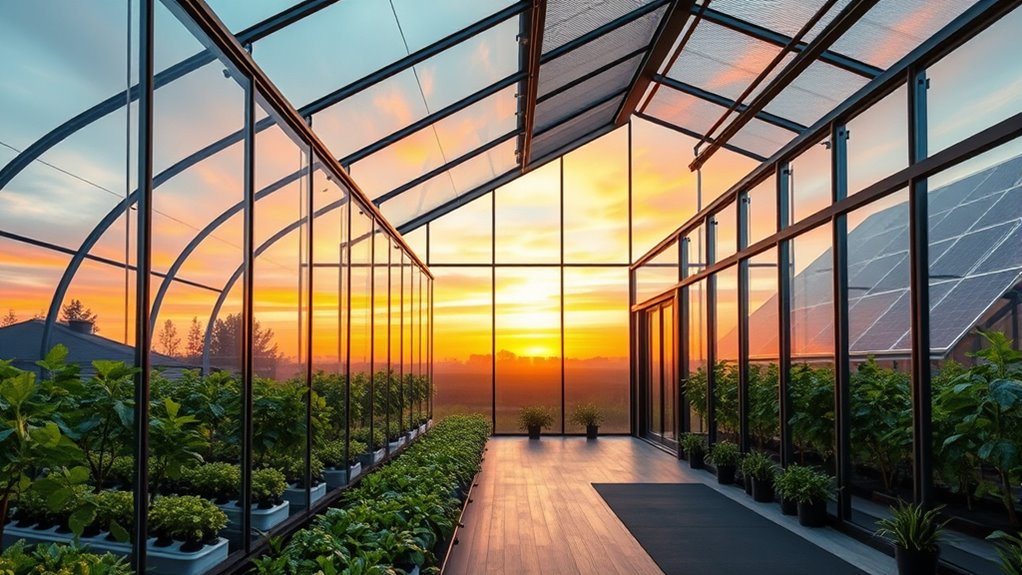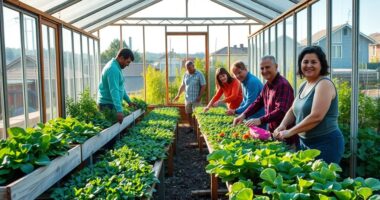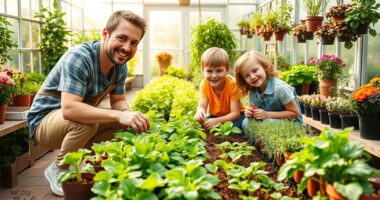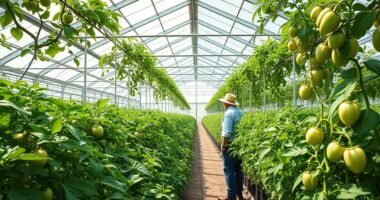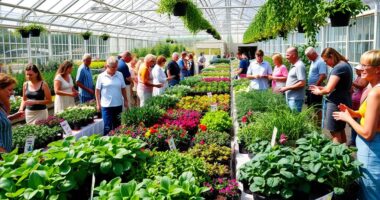Greenhouses now go far beyond traditional gardening. You can transform them into urban farms that grow food year-round, cutting down on transportation emissions. They also serve as scientific research centers, advancing crop genetics and monitoring environmental conditions. Plus, they become venues for community arts, cultural events, and educational workshops. Integrating renewable energy like solar power makes them sustainable hubs. To discover how these innovative uses bring green spaces to life, stay with us—you’ll learn more ahead.
Key Takeaways
- Transform greenhouses into cultural venues for art installations, performances, and community events that blend nature with creativity.
- Use greenhouses as educational spaces for workshops on sustainable farming, environmental conservation, and climate resilience.
- Integrate renewable energy systems like solar panels to power automation, research, and community activities within greenhouse structures.
- Repurpose greenhouses for scientific research, including genetic experiments and environmental monitoring for crop resilience and climate adaptation.
- Develop multifunctional spaces combining urban agriculture with art, cultural activities, and social programs to foster community engagement.
Sustainable Food Production and Urban Farming
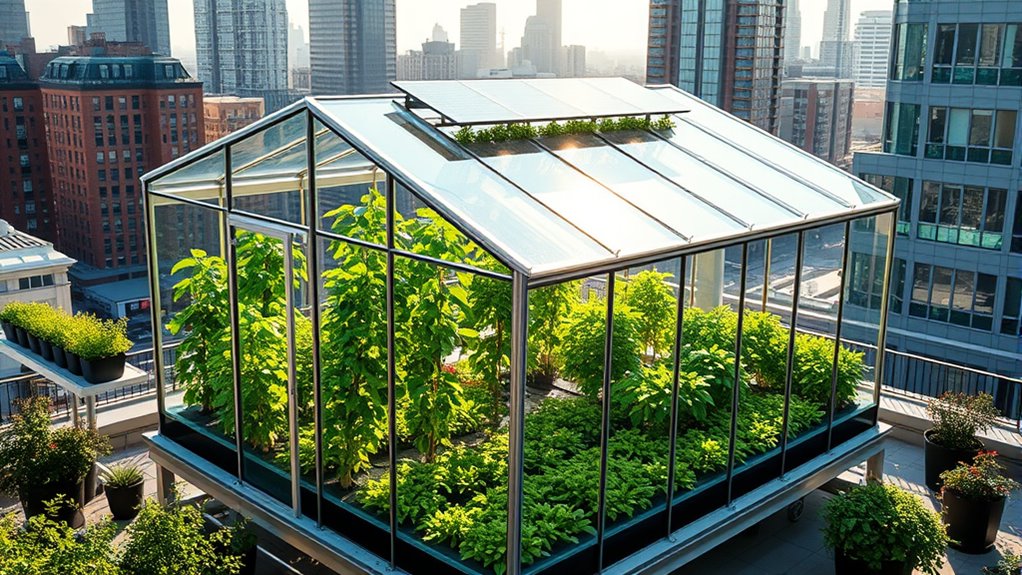
Have you ever wondered how cities can produce more of their own food sustainably? Vertical farming and urban agriculture are transforming urban spaces into productive food sources. By stacking crops vertically, you maximize limited space and reduce the need for traditional farmland.
These methods use controlled environments, often within greenhouses, to grow fresh produce year-round with less water and minimal pesticides. Urban agriculture brings food production directly into city centers, cutting down transportation emissions and increasing local food security.
Greenhouses support these initiatives by providing a stable climate, ensuring consistent yields regardless of outdoor weather conditions. As a result, cities become more self-sufficient, lowering their ecological footprint while offering fresh, nutritious food to residents.
This innovative approach redefines what’s possible in sustainable urban food production.
Scientific Research and Botanical Studies

You can explore how plant genetics are being studied to develop stronger, more resilient crops. Environmental monitoring techniques help you understand and optimize greenhouse conditions in real time. Additionally, advances in beginners guides are providing valuable insights into sustainable and efficient greenhouse management practices. These scientific advances are transforming greenhouses into hubs of botanical discovery and innovation, encouraging innovative plant breeding to improve crop performance and adaptability. Incorporating advanced sensor technology allows for more precise control of internal conditions, further enhancing research capabilities. The integration of monitoring systems enables continuous data collection, helping researchers make informed decisions. Furthermore, the implementation of noise reduction technology in greenhouse equipment minimizes disturbances, creating a more stable environment for sensitive experiments.
Research on Plant Genetics
Research on plant genetics has rapidly advanced, revealing the intricate ways genes influence growth, resilience, and productivity. You now see how genetic modification can enhance crop yields and disease resistance. Gene sequencing allows scientists to identify specific traits and develop targeted improvements. Plant genetic engineering is also being studied for its potential influence on plant growth patterns, opening new avenues for personalized cultivation strategies. Additionally, innovations in jet boat propulsion systems are enhancing the efficiency and safety of watercraft used in agricultural research and environmental monitoring. Here are four key developments:
- Accelerated development of drought-tolerant crops
- Creation of pest-resistant plant varieties
- Improved nutritional content through genetic tweaks
- Custom breeding for climate adaptability
These advances enable you to harness greenhouses more effectively, using genetic insights to optimize plant performance. By integrating genetic modification and gene sequencing, you can push the boundaries of traditional gardening, making greenhouses more productive and sustainable.
This research paves the way for a future where plant genetics directly influence innovative greenhouse applications.
Environmental Monitoring Techniques
Advancements in plant genetics have opened new possibilities for optimizing greenhouse environments, but understanding and maintaining these conditions requires precise environmental monitoring techniques.
You can achieve this through strategic sensor deployment, placing devices throughout the greenhouse to track variables like temperature, humidity, light, and soil moisture. These sensors provide real-time data, enabling you to monitor conditions accurately. Implementing emotional support strategies can also help staff manage stress related to environmental control challenges.
Once data is collected, effective data analysis helps identify patterns and detect issues before they impact plant health.
By integrating sensor deployment with thorough data analysis, you optimize environmental control, ensuring plants grow under ideal conditions.
This approach enhances research accuracy and allows for more precise botanical studies, ultimately improving greenhouse productivity and supporting innovative cultivation methods.
Renewable Energy Generation and Solar Power Integration
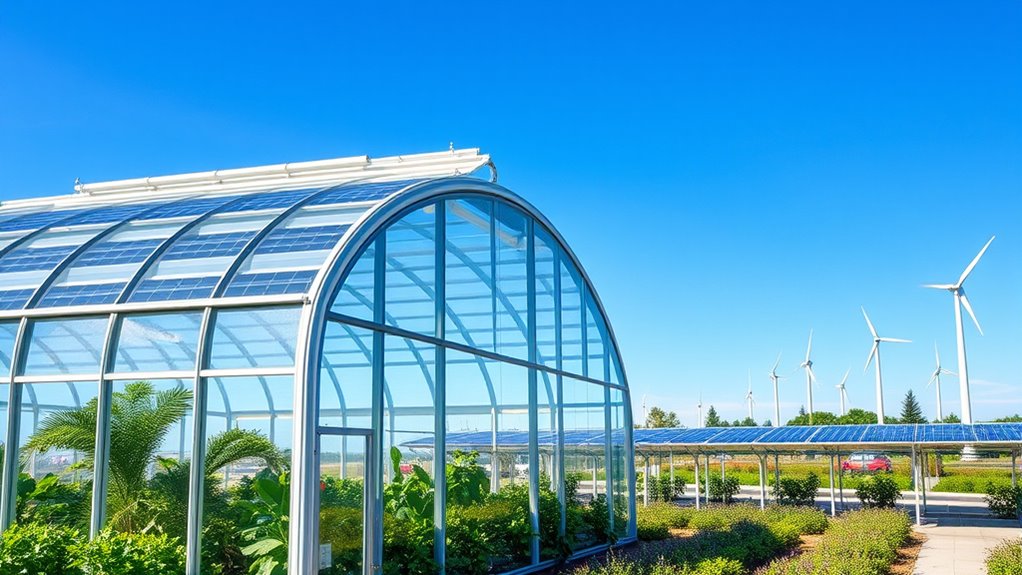
Integrating renewable energy sources into greenhouse operations has become increasingly essential for sustainable agriculture. Solar panels can be installed on roofs or nearby land to generate clean energy, reducing reliance on grid power. Utilizing nightingale studio technology can also help optimize energy management systems for better efficiency. Proper calibration of these systems ensures maximum energy output and system longevity.
To maximize efficiency, consider these four key strategies:
- Optimize solar panel placement for maximum sunlight exposure
- Invest in robust energy storage systems to supply power during cloudy days or nighttime
- Use excess energy to power heating, cooling, or automated systems
- Monitor energy consumption closely to improve overall efficiency
Education and Community Engagement Initiatives
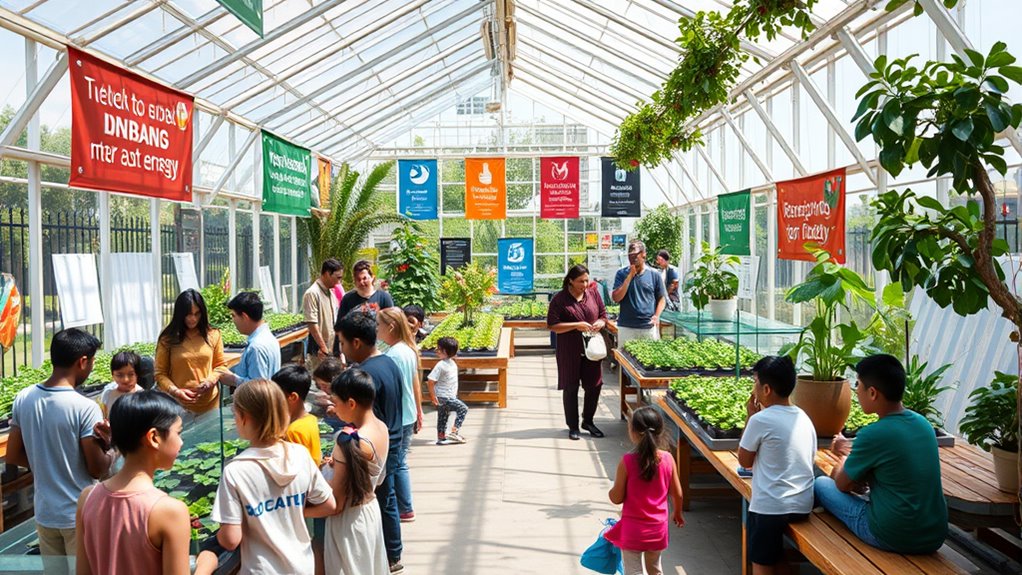
Have you considered how education and community engagement can boost the success of greenhouse projects? By hosting interactive workshops, you can teach local residents about sustainable farming, plant care, and environmental conservation. These hands-on sessions foster a sense of ownership and practical knowledge, encouraging continued involvement. Moreover, integrating community art projects within the greenhouse creates a vibrant space that attracts visitors and sparks creativity. Murals, sculptures, and plant-themed artworks can turn the greenhouse into a community hub, inspiring collaboration and pride. These initiatives not only educate but also strengthen social bonds, making the greenhouse a focal point for learning and connection. Engaging your community this way helps ensure long-term support and maximizes the greenhouse’s positive impact beyond traditional gardening. Incorporating renewable energy sources into the greenhouse infrastructure can further enhance sustainability and reduce operational costs. Additionally, fostering a culture of creative practice within these initiatives can inspire innovative ideas and solutions from community members, leveraging sustainable development goals to guide impactful projects. Exploring community involvement strategies can also amplify the reach and effectiveness of these efforts, creating a more resilient and engaged local environment. Recognizing the importance of educational outreach, such initiatives can help cultivate a deeper understanding of environmental issues among residents.
Microclimate Control for Specialized Industries
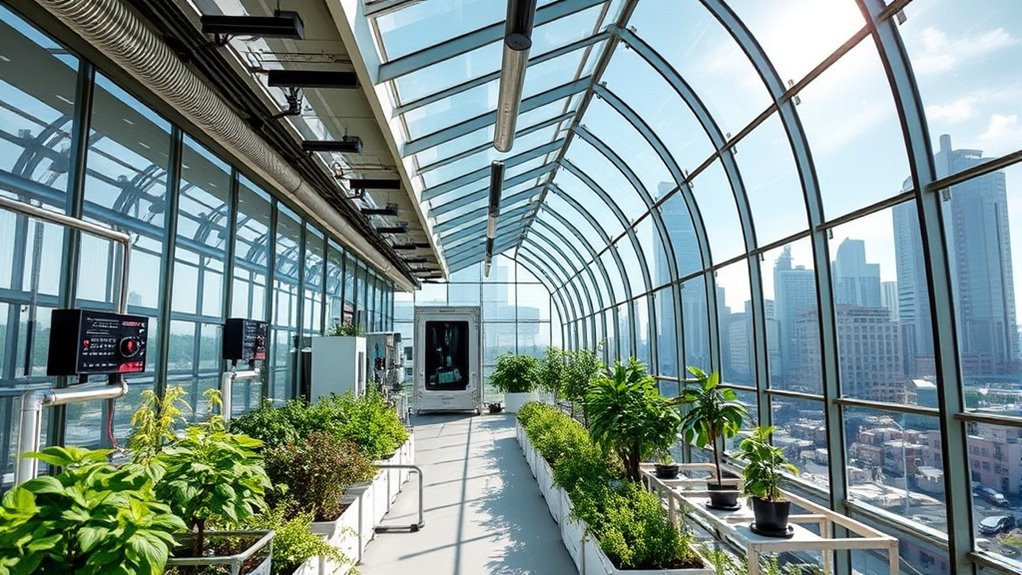
You need precise temperature regulation techniques to meet the demands of specialized industries, whether it’s maintaining cool conditions for pharmaceuticals or warmth for delicate crops.
Humidity management strategies are equally essential, ensuring environments stay ideal without risking mold or dehydration.
Mastering these microclimate controls helps you create tailored environments that boost productivity and quality.
Temperature Regulation Techniques
Effective temperature regulation is essential for maintaining ideal conditions within greenhouses dedicated to specialized industries. To achieve this, focus on key techniques like:
- Thermal insulation to minimize heat loss during cold periods and keep temperatures stable. Proper insulation can also help in reducing energy costs associated with heating and cooling. Thermal efficiency
- Airflow optimization to ensure even heat distribution and prevent hotspots or cold zones. Strategically placed vents and fans can assist in maintaining consistent airflow throughout the structure.
- Installing ventilation systems that automatically adjust to outdoor conditions. These systems help in balancing internal temperature and humidity levels, adapting dynamically as weather changes.
- Using shade cloths or reflective materials to reduce excess heat during hot days. These materials can be easily adjusted or moved to optimize shading based on daily weather patterns.
- Incorporating humidity control systems to manage moisture levels, which can influence temperature stability and plant health. Controlling humidity also helps prevent issues like mold or mildew that can arise in overly moist environments.
Humidity Management Strategies
Maintaining proper humidity levels is vital for creating a stable microclimate tailored to the needs of specialized industries within greenhouses. You can achieve this with effective misting systems that quickly add moisture when humidity drops too low.
For excess moisture, dehumidification methods like desiccant dehumidifiers or exhaust fans help control excess humidity, preventing mold and disease. Monitoring devices are essential to track humidity levels accurately, allowing you to adjust misting or dehumidifiers promptly. Additionally, using precise humidity sensors can enhance the effectiveness of your climate control strategies.
Art Installations and Cultural Events
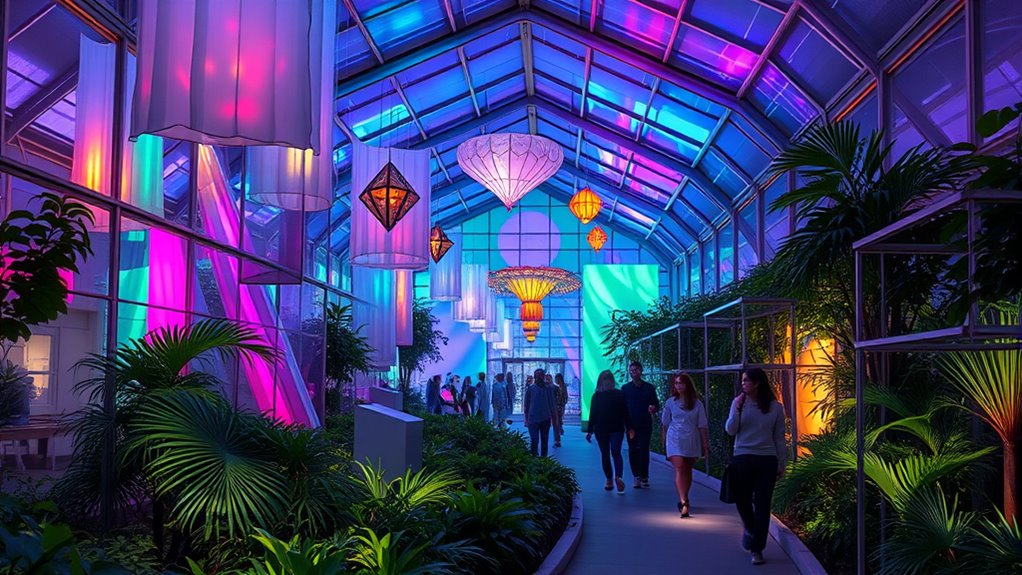
Greenhouses have become dynamic venues for art installations and cultural events, transforming traditional gardening spaces into vibrant hubs of creativity. You can host immersive experiences that showcase interactive art, drawing visitors into a blend of nature and innovation. These spaces are perfect for cultural festivals, offering a unique backdrop that enhances the event’s atmosphere.
Here are some ideas to contemplate:
- Display large-scale, interactive sculptures that engage visitors physically and visually
- Organize seasonal cultural festivals celebrating local traditions within lush surroundings
- Use transparent walls for light-based art installations that change with the time of day
- Host live performances and workshops, making the greenhouse a hub for community engagement
This approach breathes new life into greenhouses, making them versatile cultural venues. Additionally, integrating security measures can help protect valuable artworks and ensure a safe environment for visitors.
Frequently Asked Questions
How Can Greenhouses Be Adapted for Use in Extreme Climate Regions?
You can adapt greenhouses for extreme climate regions by integrating remote climate adaptation technologies, like advanced insulation and climate control systems, to withstand harsh conditions.
Use durable, insulated materials to maintain stable temperatures, and incorporate renewable energy sources like solar panels for sustainable operation.
These extreme environment solutions enable you to create controlled environments, making greenhouses viable even in the most challenging climates, supporting agriculture and research efforts effectively.
What Are Innovative Ways to Incorporate Technology Into Greenhouse Management?
You might find it no coincidence that integrating automation and data analytics revolutionizes greenhouse management.
By adopting automation integration, you streamline climate control, watering, and lighting, reducing manual effort.
Data analytics helps you monitor conditions and optimize resource use in real-time.
Together, these technologies enable you to increase yields, improve efficiency, and make smarter decisions, transforming your greenhouse into a highly responsive, sustainable operation that adapts seamlessly to changing needs.
Can Greenhouses Be Used for Waste Recycling or Waste-To-Energy Processes?
You can definitely use greenhouses for waste recycling or waste-to-energy processes. Installing composting systems inside a greenhouse allows you to convert organic waste into nutrient-rich compost efficiently.
Additionally, greenhouses can facilitate waste conversion by integrating biogas digesters, which convert organic waste into energy. This setup not only promotes sustainability but also helps manage waste locally, turning what would be discarded into valuable resources within the controlled environment of a greenhouse.
How Do Greenhouses Influence Local Biodiversity Beyond Plant Cultivation?
You might think greenhouses only support cultivated plants, but they also influence local biodiversity. By creating controlled environments, you can foster pollinator habitats and protect native species from harsh weather.
This reduces the risk of invasive species taking over. Greenhouses serve as safe havens, encouraging native flora and fauna to thrive, ultimately enriching your local ecosystem and promoting long-term ecological balance beyond just gardening.
Are There Emerging Methods for Converting Greenhouses Into Temporary Shelters?
You might wonder if greenhouses can serve as emergency shelters or aid disaster relief efforts. Yes, emerging methods focus on quick modifications, like reinforcing structures and adding insulation, to convert greenhouses into temporary shelters.
These adaptable spaces offer protection, warmth, and a safe environment during emergencies. Their modular design allows easy setup, making greenhouses a practical solution for disaster relief, especially in areas needing rapid shelter deployment.
Conclusion
Imagine transforming a simple greenhouse into a hub for urban farming, where you grow fresh produce right in the city. For example, in Brooklyn, a community greenhouse now supplies local restaurants and hosts educational workshops. By thinking creatively, you can turn greenhouses into versatile spaces that benefit your community, support sustainability, and inspire innovation. So, why not explore these new uses and make your greenhouse a catalyst for positive change?
